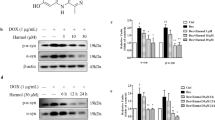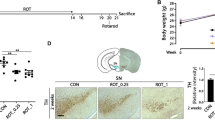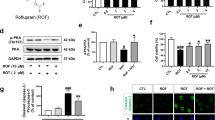Abstract
The accumulation of misfolded α-synuclein in dopamine (DA) neurons is believed to be of major importance in the pathogenesis of Parkinson’s disease (PD). Animal models of PD, based on viral-vector-mediated over-expression of α-synuclein, have been developed and show evidence of dopaminergic toxicity, providing us a good tool to investigate potential therapies to interfere with α-synuclein-mediated pathology. An efficient disease-modifying therapeutic molecule should be able to interfere with the neurotoxicity of α-synuclein aggregation. Our study highlighted the ability of an autophagy enhancer, trehalose (at concentrations of 5 and 2 % in drinking water), to protect against A53T α-synuclein-mediated DA degeneration in an adeno-associated virus serotype 1/2 (AAV1/2)-based rat model of PD. Behavioral tests and neurochemical analysis demonstrated a significant attenuation in α-synuclein-mediated deficits in motor asymmetry and DA neurodegeneration including impaired DA neuronal survival and DA turnover, as well as α-synuclein accumulation and aggregation in the nigrostriatal system by commencing 5 and 2 % trehalose at the same time as delivery of AAV. Trehalose (0.5 %) was ineffective on the above behavioral and neurochemical deficits. Further investigation showed that trehalose enhanced autophagy in the striatum by increasing formation of LC3-II. This study supports the concept of using trehalose as a novel therapeutic strategy that might prevent/reverse α-synuclein aggregation for the treatment of PD.







Similar content being viewed by others
References
Dawson TM, Dawson VL (2003) Molecular pathways of neurodegeneration in Parkinson’s disease. Science 302:819–822
Siderowf A, Stern M (2003) Update on Parkinson disease. Ann Intern Med 138:651–658
Iwatsubo T (2003) Aggregation of alpha-synuclein in the pathogenesis of Parkinson’s disease. J Neurol 250(Suppl 3):III11–III14
Cole NB, Murphy DD, Lebowitz J, Di Noto L, Levine RL, Nussbaum RL (2005) Metal-catalyzed oxidation of alpha-synuclein: helping to define the relationship between oligomers, protofibrils, and filaments. J Biol Chem 280:9678–9690
Chiba-Falek O, Lopez GJ, Nussbaum RL (2006) Levels of alpha-synuclein mRNA in sporadic Parkinson disease patients. Mov Disord 21:1703–1708
Polymeropoulos MH, Lavedan C, Leroy E, Ide SE, Dehejia A, Dutra A, Pike B, Root H et al (1997) Mutation in the alpha-synuclein gene identified in families with Parkinson’s disease. Science 276:2045–2047
Singleton AB, Farrer M, Johnson J, Singleton A, Hague S, Kachergus J, Hulihan M, Peuralinna T et al (2003) Hardy JGwinn-Hardy K: alpha-Synuclein locus triplication causes Parkinson’s disease. Science 302:841
Song W, Patel A, Qureshi HY, Han D, Schipper HM, Paudel HK (2009) The Parkinson disease-associated A30P mutation stabilizes alpha-synuclein against proteasomal degradation triggered by heme oxygenase-1 over-expression in human neuroblastoma cells. J Neurochem 110:719–733
Banerjee R, Beal MF, Thomas B (2010) Autophagy in neurodegenerative disorders: pathogenic roles and therapeutic implications. Trends Neurosci 33:541–549
Rubinsztein DC, Gestwicki JE, Murphy LO, Klionsky DJ (2007) Potential therapeutic applications of autophagy. Nat Rev Drug Discov 6:304–312
Ravikumar B, Duden R, Rubinsztein DC (2002) Aggregate-prone proteins with polyglutamine and polyalanine expansions are degraded by autophagy. Hum Mol Genet 11:1107–1117
Ravikumar B, Vacher C, Berger Z, Davies JE, Luo S, Oroz LG, Scaravilli F, Easton DF et al (2004) Inhibition of mTOR induces autophagy and reduces toxicity of polyglutamine expansions in fly and mouse models of Huntington disease. Nat Genet 36:585–595
Jain NK, Roy I (2009) Effect of trehalose on protein structure. Protein Sci 18:24–36
Richards AB, Krakowka S, Dexter LB, Schmid H, Wolterbeek AP, Waalkens-Berendsen DH, Shigoyuki A, Kurimoto M (2002) Trehalose: a review of properties, history of use and human tolerance, and results of multiple safety studies. Food Chem Toxicol 40:871–898
Emanuele E (2014) Can trehalose prevent neurodegeneration? Insights from experimental studies. Curr Drug Targets 15:551–557
Sarkar S, Davies JE, Huang Z, Tunnacliffe A, Rubinsztein DC (2007) Trehalose, a novel mTOR-independent autophagy enhancer, accelerates the clearance of mutant huntingtin and alpha-synuclein. J Biol Chem 282:5641–5652
Wolkers WF, Walker NJ, Tablin F, Crowe JH (2001) Human platelets loaded with trehalose survive freeze-drying. Cryobiology 42:79–87
Löw K, Aebischer P (2012) Use of viral vectors to create animal models for Parkinson’s disease. Neurobiol Dis 48:189–201
Koprich JB, Johnston TH, Huot P, Reyes MG, Espinosa M, Brotchie JM (2011) Progressive neurodegeneration or endogenous compensation in an animal model of Parkinson’s disease produced by decreasing doses of alpha-synuclein. PLoS One 6:e17698
Koprich JB, Johnston TH, Reyes MG, Sun X, Brotchie JM (2010) Expression of human A53T alpha-synuclein in the rat substantia nigra using a novel AAV1/2 vector produces a rapidly evolving pathology with protein aggregation, dystrophic neurite architecture and nigrostriatal degeneration with potential to model the pathology of Parkinson’s disease. Mol Neurodegener 5:43
Kabeya Y, Mizushima N, Ueno T, Yamamoto A, Kirisako T, Noda T, Kominami E, Ohsumi Y et al (2000) LC3, a mammalian homologue of yeast Apg8p, is localized in autophagosome membranes after processing. EMBO J 19:5720–5728
Sarkar S, Perlstein EO, Imarisio S, Pineau S, Cordenier A, Maglathlin RL, Webster JA, Lewis TA et al (2007) Small molecules enhance autophagy and reduce toxicity in Huntington’s disease models. Nat Chem Biol 3:331–338
Mizushima N, Yamamoto A, Matsui M, Yoshimori T, Ohsumi Y (2004) In vivo analysis of autophagy in response to nutrient starvation using transgenic mice expressing a fluorescent autophagosome marker. Mol Biol Cell 15:1101–1111
Tanida I, Ueno T, Kominami E (2004) LC3 conjugation system in mammalian autophagy. Int J Biochem Cell Biol 36:2503–2518
Pickford F, Masliah E, Britschgi M, Lucin K, Narasimhan R, Jaeger PA, Small S, Spencer B et al (2008) The autophagy-related protein beclin 1 shows reduced expression in early Alzheimer disease and regulates amyloid beta accumulation in mice. J Clin Invest 118:2190–2199
Webb JL, Ravikumar B, Atkins J, Skepper JN, Rubinsztein DC (2003) Alpha-Synuclein is degraded by both autophagy and the proteasome. J Biol Chem 278:25009–25013
Casarejos MJ, Solano RM, Gomez A, Perucho J, de Yebenes JG, Mena MA (2011) The accumulation of neurotoxic proteins, induced by proteasome inhibition, is reverted by trehalose, an enhancer of autophagy, in human neuroblastoma cells. Neurochem Int 58:512–520
Tanaka M, Machida Y, Niu S, Ikeda T, Jana NR, Doi H, Kurosawa M, Nekooki MNukina N (2004) Trehalose alleviates polyglutamine-mediated pathology in a mouse model of Huntington disease. Nat Med 10:148–154
Schaeffer V, Lavenir I, Ozcelik S, Tolnay M, Winkler DT, Goedert M (2012) Stimulation of autophagy reduces neurodegeneration in a mouse model of human tauopathy. Brain 135:2169–2177
Yu WB, Jiang T, Lan DM, Lu JH, Yue ZY, Wang J, Zhou P (2012) Trehalose inhibits fibrillation of A53T mutant alpha-synuclein and disaggregates existing fibrils. Arch Biochem Biophys 523:144–150
Lan DM, Liu FT, Zhao J, Chen Y, Wu JJ, Ding ZT, Yue ZY, Ren HM et al (2012) Effect of trehalose on PC12 cells overexpressing wild-type or A53T mutant α-synuclein. Neurochem Res 37:2025–2032
Sarkar S, Chigurupati S, Raymick J, Mann D, Bowyer JF, Schmitt T, Beger RD, Hanig JP et al (2014) Neuroprotective effect of the chemical chaperone, trehalose in a chronic MPTP-induced Parkinson’s disease mouse model. Neurotoxicology 44:250–262
Chung CY, Koprich JB, Siddiqi H, Isacson O (2009) Dynamic changes in presynaptic and axonal transport proteins combined with striatal neuroinflammation precede dopaminergic neuronal loss in a rat model of AAV alpha-synucleinopathy. J Neurosci 29:3365–3373
Minutoli L, Altavilla D, Bitto A, Polito F, Bellocco E, Lagana G, Fiumara T, Magazu S et al (2008) Trehalose: a biophysics approach to modulate the inflammatory response during endotoxic shock. Eur J Pharmacol 589:272–280
Echigo R, Shimohata N, Karatsu K, Yano F, Kayasuga-Kariya Y, Fujisawa A, Ohto T, Kita Y et al (2012) Trehalose treatment suppresses inflammation, oxidative stress, and vasospasm induced by experimental subarachnoid hemorrhage. J Transl Med 10:80
Li J, Roubeix C, Wang Y, Shi S, Liu G, Baudouin C, Chen W (2012) Therapeutic efficacy of trehalose eye drops for treatment of murine dry eye induced by an intelligently controlled environmental system. Mol Vis 18:317–329
Wang YQ, Tu ZC, Xu XY, Li R, Qu WM, Urade Y, Huang ZL (2012) Acute administration of fluoxetine normalizes rapid eye movement sleep abnormality, but not depressive behaviors in olfactory bulbectomized rats. J Neurochem 120:314–324
Hong ZY, Huang ZL, Qu WM, Eguchi N (2005) Orexin A promotes histamine, but not norepinephrine or serotonin, release in frontal cortex of mice. Acta Pharmacol Sin 26:155–159
Chu Y, Kordower JH (2007) Age-associated increases of alpha-synuclein in monkeys and humans are associated with nigrostriatal DA depletion: Is this the target for Parkinson’s disease? Neurobiol Dis 25:134–149
Chu Y, Dodiya H, Aebischer P, Olanow CW, Kordow-er JH (2009) Alterations in lysosomal and proteasomal markers in Parkinson’s disease: relationship to alpha-synuclein inclusions. Neurobiol Dis 35:385–398
Acknowledgments
This work was supported by grants from the National Foundation of Natural Science of China (No.81071018 and No.81371413), key project from Science and Technology Commission of Shanghai Municipality (13JC1401103), and project of Shanghai Municipal Commission of Health (XBR2013088). The funders had no role in study design, data collection and analysis, decision to publish, or preparation of the manuscript. We thank Dr. Shun Yu from Xuanwu Hospital of the Capital University of Medical Sciences, Beijing, China, for kindly providing the human α-synuclein antibody for immunofluorescence.
Conflict of interest
The authors declare that they have no competing interests.
Authors’ contributions
WJ, Koprich JB, and Brotchie JM designed this study. HQ, WY, and YWB performed this study, analyzed data, and wrote the manuscript. XBG assisted in behavioral analysis. All authors discussed the results and provided comments on the manuscript. All authors read and approved the final manuscript.
Author information
Authors and Affiliations
Corresponding authors
Additional information
Qing He and James B. Koprich contributed equally to this work.
Rights and permissions
About this article
Cite this article
He, Q., Koprich, J.B., Wang, Y. et al. Treatment with Trehalose Prevents Behavioral and Neurochemical Deficits Produced in an AAV α-Synuclein Rat Model of Parkinson’s Disease. Mol Neurobiol 53, 2258–2268 (2016). https://doi.org/10.1007/s12035-015-9173-7
Received:
Accepted:
Published:
Issue Date:
DOI: https://doi.org/10.1007/s12035-015-9173-7




